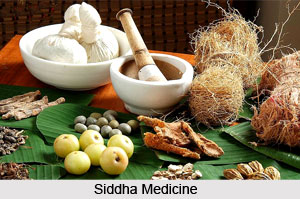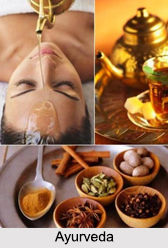 In Panchakarma, proper preparation of nasya treatment is crucial. Ayurveda describes that preparation of the elimination process is very much essential. In case of nasya treatment, before the medicated drops or powders are administered, warm herbalized oil is thoroughly massaged into the face of the patient mainly focussing on the sinus areas. After that, fomentation, using a hot water bottle wrapped in a hot, moist cloth or towel, is applied to the face and neck to dilate the passageways. Generally, Ayurveda prohibits applying heat to head. But nasya therapy is an exception in this regard.
In Panchakarma, proper preparation of nasya treatment is crucial. Ayurveda describes that preparation of the elimination process is very much essential. In case of nasya treatment, before the medicated drops or powders are administered, warm herbalized oil is thoroughly massaged into the face of the patient mainly focussing on the sinus areas. After that, fomentation, using a hot water bottle wrapped in a hot, moist cloth or towel, is applied to the face and neck to dilate the passageways. Generally, Ayurveda prohibits applying heat to head. But nasya therapy is an exception in this regard.
The second step that is after the localized snehana and swedana, the patient has his head tilted back and receives either herbalized drops in each nostril or powders blown in forcefully. To draw the medications more deeply into the passageways, the patient pinches his nostrils closed on the inhale and releases suddenly. If the treatment uses many penetrating and hot substances, it may cause a temporary burning sensation. The patient is prepared accordingly. After a while, the dislodged kapha and aama start to flow back into the hollow channels of the mouth, nose and throat.
There are several ways of administration of nasya. The first process is the avapidana, which literally means squeezing. In this step, juices extracted from fresh herbs are dripped into the nasal passages. It cleanses and soothes the para-nasal sinus area. Ayurveda employs this process for headache, insomnia and anxiety. The second way of administering nasya treatment is known as pradhamana that literally means forcefully pushing. This method has a strong cleansing action and gives immediate relief from severe headaches, disorientation, dizziness and fainting. There are some more steps for the administration of nasya therapy that are milder procedures comparatively as they use weaker and fewer herbs. These procedures are called as marsha nasya and prati marsha nasya or better known as repeated applications. In these procedures, the herbs are not propelled as deeply into the nasal passages. The herbs are applied in a sesame oil base.
The nasya therapy cleans strengthens and lubricates the mucous membranes keeping the nasal passages open and increases resistance to foreign substances. The treatment basically starts with four drops of herbalized oil in each nostril. This treatment is performed for seven days continuously. Sometimes, a series of treatments may be necessary to treat several conditions like allergies, migraine and epilepsy. During the kapha dominant periods or for kapha disorders, cleansing nasya using hot penetrating substances in oil is used. Nasyas for vata and pitta conditions are extremely nourishing and soothing. In pitta conditions that are indicated by burning sensations and nose bleeds, ghee is used and the therapy is usually administered at the midnight or midday. But, in vata conditions, nasya is performed usually in late afternoon. The best time to offer nasya treatment is right after snehana and swedana. Usage of improper herbs or dosages may cause discomfort to the patient.
Thus, Ayurveda proves that after the proper preparation and administration of nasya treatment, the patient`s head feels less congested and lighter and senses more acute.




















